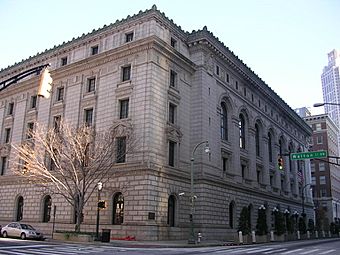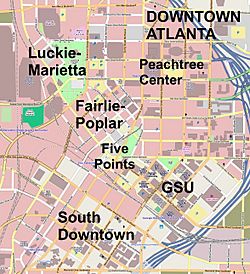Elbert P. Tuttle United States Court of Appeals Building facts for kids
|
U.S. Post Office and Courthouse
|
|

Elbert P. Tuttle U.S. Courthouse, November 2007
|
|
| Location | 56 Forsyth St., Atlanta, Georgia |
|---|---|
| Area | 1 acre (0.40 ha) |
| Built | 1910 |
| Architect | Taylor, James Knox |
| Architectural style | Renaissance Revival |
| NRHP reference No. | 74000681 |
Quick facts for kids Significant dates |
|
| Added to NRHP | May 2, 1974 |
| Designated NHL | July 20, 2015 |
The Elbert P. Tuttle U.S. Court of Appeals Building is a very old and important building in Atlanta, Georgia. It's also known as the U.S. Post Office and Courthouse. This historic building is designed in a style called Renaissance Revival. It's located in the Fairlie-Poplar area of Downtown Atlanta in Fulton County, Georgia.
This building is special because it's where the United States Court of Appeals for the Eleventh Circuit hears cases. Many important decisions about civil rights were made here. Because of its history, it was added to the National Register of Historic Places in 1974. It was also named a National Historic Landmark in 2015, which means it's a place of national importance.
History of the Building
After the American Civil War, Atlanta grew very quickly. More people meant more need for government services. So, the government decided to build a new place for both the post office and the courts. When they started digging in 1907, workers found a rock that looked like an American eagle! People thought this was a good sign for the new federal building.
James Knox Taylor, who was the main architect for government buildings at the time, designed it. The building was finished in 1910. People in the news said it was a big step in making Atlanta more beautiful.
In 1981, a new court called the Eleventh Circuit Court of Appeals started using the building. Later, in 1989, the building was renamed to honor a famous judge named Elbert Parr Tuttle.
Many important cases have been heard in this courthouse. For example, in 2000, the court made a decision about a young Cuban boy named Elian Gonzalez. He was found off the coast of Florida. The court decided he should go back to his father in Cuba. In the same year, the court also handled some lawsuits related to the presidential election. These cases showed how important the court's role is in solving big national issues.
What the Building Looks Like
James Knox Taylor designed the Elbert P. Tuttle U.S. Court of Appeals Building in a style called Second Renaissance Revival. This grand style was often used for federal buildings in the early 1900s.
The building takes up a whole city block in downtown Atlanta. It's five stories tall and shaped like a "U" with a central open space. The outside walls facing the streets are made of granite, a strong stone. The inner walls around the courtyard are made of buff-colored brick.
The front of the building faces Forsyth Street. The first floor has rough-cut granite and round-arched doorways. A decorative band separates the first and second floors. The windows on the second floor have small classical railings and fancy carvings. The third and fourth floors have large, round-arched windows with decorative carvings above them. These big windows show where the courtrooms are inside. Between these arched windows are attached columns and round decorations. The top floor has smaller rectangular windows with decorative ovals. The very top of the building has a heavy, fancy ledge with small rectangular blocks and carved leaf designs.
Other sides of the building have similar details, but without the two-story arched windows. Some windows have carvings of a serpent and staff. This symbol was linked to Mercury, the Roman messenger god, and was an early symbol for the postal service. There's also an iron arch over a loading area in the courtyard.
Inside, many of the original parts are still there. The main lobby on the first floor has a beautiful arched ceiling. The walls are covered with marble and plaster. The original bronze windows are still in place. Under each window, there's a marble table for letters. The floors were once marble but now have green and gray terrazzo, which is a type of flooring made of stone chips. There's also a painting showing Justice, with figures representing farming and industry. A grand staircase with marble steps and a cast-iron railing leads to the upper floors.
The main courtrooms on the third floor are very impressive. The biggest one is a two-story courtroom where all the appellate judges can meet to hear a case. The walls are covered with beautifully carved oak wood. Large arched windows are balanced by similar arched spaces on the opposite walls. There are also bronze grilles. The floor is made of maple wood in a pattern called herringbone. The ceiling is very fancy, with carved squares and flower designs. Another courtroom is a bit smaller but just as nice, with similar wood walls and floors. It also has oak benches for people to sit and watch.
Important Dates
- 1906-1910: The U.S. Post Office and Courthouse was built.
- 1974: The building was added to the National Register of Historic Places.
- 1981: The U.S. Court of Appeals (Eleventh Circuit) started using the building.
- 1989: The building was renamed to honor Judge Elbert Parr Tuttle.
- 2000: Important cases like the Elian Gonzalez case and those related to the Bush v. Gore election were heard here.
- 2015: The building was named a National Historic Landmark.
Building Facts
- Location: 56 Forsyth Street
- Architect: James Knox Taylor
- Built: 1906-1910
- Style: Second Renaissance Revival
- Special Status: Listed on the National Register of Historic Places and part of the Fairlie Poplar Historic District.
- Main Material: Granite
- Cool Features: Fancy classical outside design; Arched lobby ceiling


